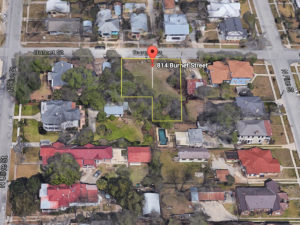
SOLD – 814 Burnet – Dignowity Hill
This shovel ready in-fill site went quickly! Watch for four new homes to be built in the near future.

SOLD – 814 Burnet – Dignowity Hill
This shovel ready in-fill site went quickly! Watch for four new homes to be built in the near future.
Shovel ready In-fill site in prime location in Dignowity Hill Historic District. The property has been successfully replatted and recorded into four separate legal lots with IDZ AHOD zoning approved. Mid-block site located a half block away from Dignowity and Lockwood Parks. Registered for ICRIP tax credits. Buyer to create new architectural plans. Minutes from Hays Street Bridge, Alamo Brewery, Burleson Yard Beer Garden, and downtown. Quick access to major highways. **Click on the photo for more information and photos.**
A fellow blogger, Juan A. Garcia the President of the Dignowity Hill Association, posted this from a Syracuse Cultural Workers Poster. I couldn’t agree more.
Turn off your TV- Leave your house
Know your neighbors – Look up when you are walking
Greet people -Sit on your stoop
Plant Flowers – Use your library
Play together – Buy from local merchants -Share what you have
Help a lost dog -Take children to the park
Garden Together -Support Neighborhood Schools
Fix it even if you didn’t break it
Have Pot Lucks- Honor Elders
Pick Up Litter – Read Stories Aloud
Dance in the Street- Talk to the Mail Carrier
Listen to the Birds -Put up a Swing
Help Carry Something Heavy -Barter For Your Goods
Start A Tradition- Ask A Question
Hire Young People for Odd Jobs- Organize a Block Party
Bake Extra and Share- Ask For Help When You Need It
Open Your Shades -Sing Together
Share Your Skills -Take Back the Night
Turn Up The Music -Turn Down The Music
Listen Before You react To Anger
Mediate A Conflict -Seek To Understand
Learn From New And Uncomfortable Angles
Know That No One is Silent Though Many Are Not Heard
Work To Change This
Source: Syracuse Cultural Workers Poster: How to Build Community
I took part in the King Willliam/Lavaca 5K History Run back in May and was embarrassed at my lack of ability to keep up with the runners. It has clearly been years since my days of running track in high school!! I wish I would have known there were multiple groups on this “run.” I would have taken the “moms with strollers” walk!
San Antonio’s Office of Historic Preservation is doing a great job of engaging the public and creating fun events to learn about this city’s history.
This is a nice write-up of the event by John Tedesco with the Express-News.
There are many ways to learn about a city and its history — but not many involve putting on a jogging outfit and trying to keep up with Amy Unger.
On Saturday, about 45 people showed up for a three-mile run through the East Side near downtown, which offered a unique perspective of a struggling neighborhood that many people simply glimpse at on their way to Spurs games.
“I’ve lived in San Antonio my entire life and really don’t know anything about the neighborhood,” said jogger Sarah Deosdade.
Unger and her other fit colleagues at the city’s Office of Historic Preservation have been leading runners on tours through historic parts of San Antonio. They started the free program in May, Historic Preservation Month.
District 2 Councilwoman Ivy Taylor invited the city’s history experts to explore the East Side, home of the grand houses of Dignowity Hill and the recently restored Hays Street Bridge.
Participants gathered at the Carver Community Cultural Center and had the option of tagging along with Unger or two other guides. Some joggers who showed up looked like triathletes, but the program is for everyone — the slowest group walked and a few people pushed children in strollers.
The three groups set out at 7:30 a.m. and stopped periodically to hear a brief history lesson, like the one on Dignowity Hill. Unger pointed out a tall, well-kept house.
“Edward Friedrich — we saw his massive air conditioning company — he lived in this house here, this yellow house, which is a really excellent example of the Queen Anne style,” she said.
One theme of the tour was the impact of freeways built in the 1960s that segmented downtown and cut off neighborhoods.
“Large freeways were driven through the heart of many of our cities,” Unger said, speaking above the soft roar of traffic on nearby U.S. 281. “It cut off a lot of neighborhoods from downtown, and that’s when you saw a lot of the urban decay that kind of peaked in the 1980s.”
When three noisy tour buses interrupted her talk during another part of the jog, Unger laughed and pointed out how much more people can learn about a community just by being outside.
“Wouldn’t you much rather be out on the ground, getting a workout?” she asked. “You get to see so much more.”